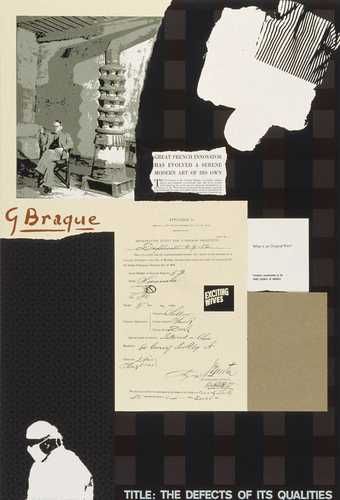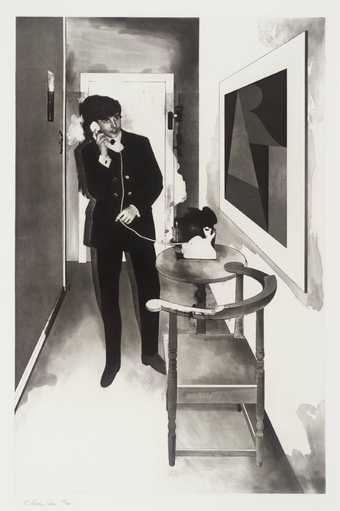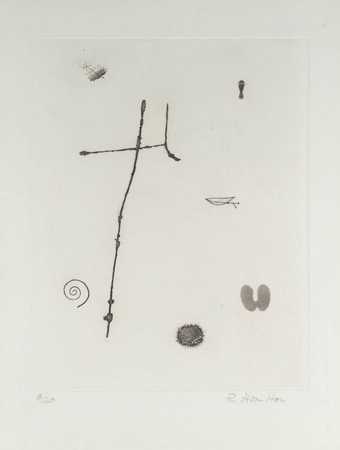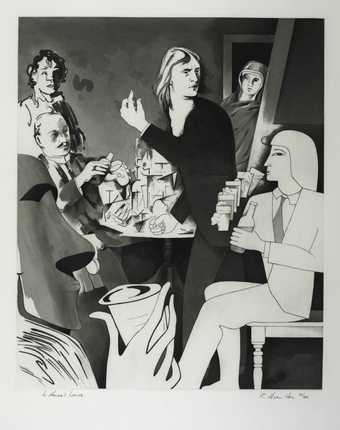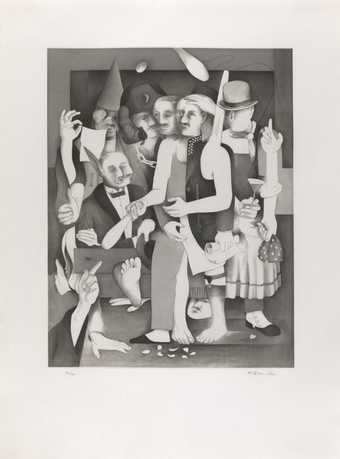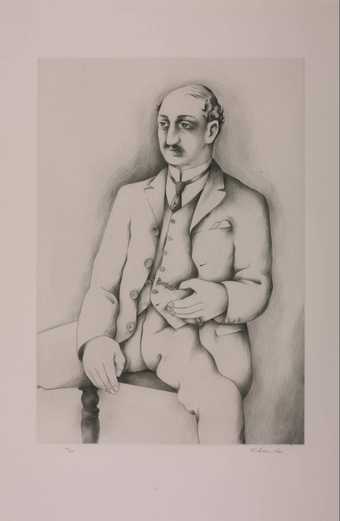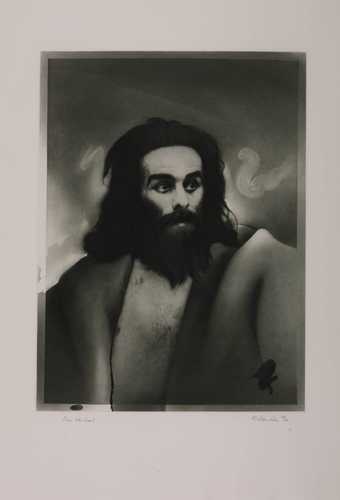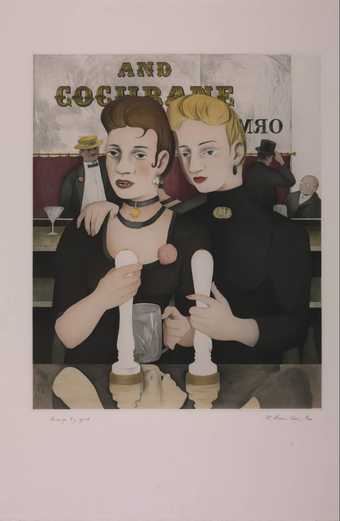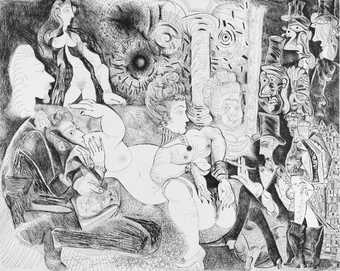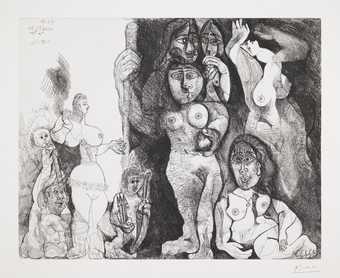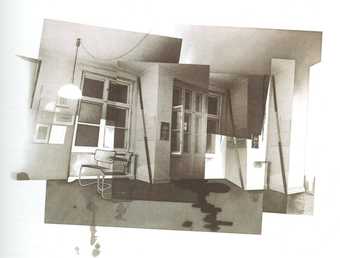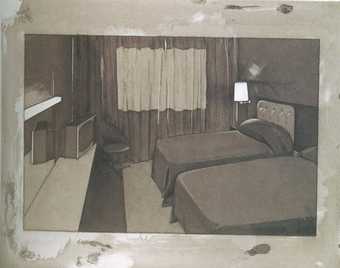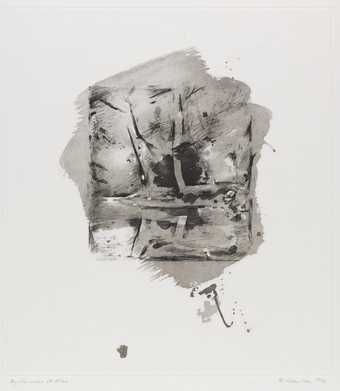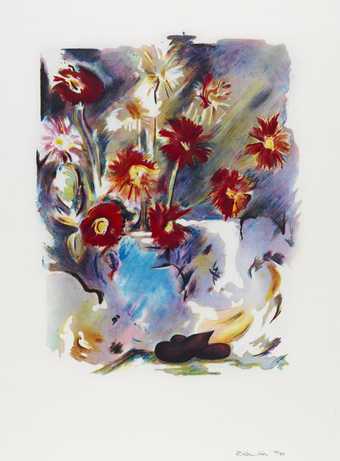
In Tate Britain
Prints and Drawings Room
View by appointment- Artist
- Richard Hamilton 1922–2011
- Medium
- Etching on paper
- Dimensions
- Image: 570 × 490 mm
- Collection
- Tate
- Acquisition
- Purchased 1982
- Reference
- P07659
Summary
Picasso’s meninas is an etching that plays an art-historical game by combining the composition of the celebrated painting by Diego Velázquez, Las Meniñas, 1656 (Museo del Prado, Madrid), with the graphic styles of Pablo Picasso (1881-1973). The print came about as a result of a commission: Hamilton was invited by the Propylaen Press, Berlin to contribute to their portfolio Hommage à Pablo Picasso, celebrating Picasso’s ninetieth birthday in 1971. Feeling that any homage to Picasso would have to involve ‘displaying respect for the masterly craftsmanship and love of the medium that Picasso demonstrated in his own etchings’ (Hamilton in Collected Words, p.106), the artist made his contribution conditional on Picasso’s etcher, Aldo Crommelynck, agreeing to work with him. This was his first consideration before any thought of a subject for his print. Hamilton wrote:
I saw Velásquez’ Las Meniñas at the Prado for the first time in 1972 – its reputation as being among the greatest paintings that exist is well founded. The temptation to paraphrase Velásquez in Picasso’s styles proved irresistible ... Las Meniñas provided an opportunity to run the gamut of Picasso’s ‘periods’ in one plate – from ‘Rose’ through ‘Analytical Cubism’ to ‘Primitive’ to ‘Neo-Classical’ and so on. The stage of Velásquez’ Meniñas could carry a lot of action, and the mysterious ambiguities (it seems to contain an infinity of cross reflections with the space the picture confronts), allowed some narrative interplay with substitutions of personalities as well as styles.
(Quoted in Collected Words, p.106.)
Picasso had himself created forty-four analyses of Velásquez’s painting between August and December 1957, now hanging in the Museo Picasso, Barcelona. His versions of Las Meniñas, which include single characters from the original, are stylistically homogenous in the artist’s signature modernist style based on simplified geometric forms and dark line. By contrast, Hamilton’s homage inserts representational styles spanning the first half of the twentieth century into the seventeenth century composition. As his title suggests, Hamilton made the image of Picasso the most significant face in the group portrait. The subjects of the original painting – the centrally placed Infanta and her entourage or ‘meniñas’ (the Portuguese word for girls, which came to mean maid of honour in the Spanish court) – have been transformed into the entourage of Picasso, the most realistically rendered character in the print. His portrait replaces the self-portrait of Velásquez, who painted himself standing next to the easel on which he is apparently working. In Hamilton’s print Picasso is ornamented with a hammer and sickle (referring to his communist sympathies) to replace the red cross of Santiago (the cross of St James) on Velásquez’s chest.
Hamilton drew the Infanta (the Spanish princess) in the style of Picasso’s Analytical Cubism of 1912. The lady-in-waiting standing on her left is depicted in the flat graphic language Picasso developed in the 1930s. Behind her, another female attendant is depicted in Picasso’s neo-classical style of the early 1920s and a male figure is drawn using spare lines and the vocabulary of African forms that Picasso was using around 1907. The female dwarf of the seventeenth century original has become a version of Picasso’s Seated Woman, 1927 (Art Gallery of Ontario, Toronto). Hamilton copied a harlequin from Picasso’s ‘pink’ period to replace the page in Velásquez’s painting, and a bull, closely resembling a painting of a dying bull that Picasso made in 1934 (Dying Bull, private collection, Switzerland) to replace the mastiff on which the seventeenth century page places his foot. He drew representations of Picasso’s paintings, L’Aubade, 1942 (Musée d’art moderne, Centre Georges Pompidou, Paris) and Three Musicians, 1921 (Museum of Modern Art, New York), on the wall behind the group of figures. Finally, in the mirror – the conceptual focal point of Velásquez’s painting, where King Philip IV of Spain and his consort Mariana, parents of the Infanta, appear as shadowy onlookers of the painting’s scene – Hamilton inserted himself and his girlfriend (later wife), the artist Rita Donagh (born 1939). According to Lullin: ‘They are rendered with a particular etching technique “invented” by Picasso. A mark drawn on an aquatint ground with a greasy crayon, such as lithographic chalk, will act as a resist to the acid and produce a white mark when printed.’ (Lullin, p.124.) Because of this technique, the two figures appear painted in the print.
A total of sixty-nine artists contributed to the Hommage à Picasso edition, which was split into six portfolios. Some of these are reproduced in the catalogue of the exhibition of the same title that was held in the Nationalgalerie, Berlin in 1973. Hamilton created three studies for Picasso’s meninas (study I, II and II, 1973, collection Rita Donagh, Northend) before he created the etching plate in Paris. He later developed the imitation and mixture of historical styles in a single image in the print In Horne’s house, 1981-2 (P77483), where Cubism again features centrally, this time in the depiction of a spread of sardines and beer.
Picasso’s meninas was printed by Pierro and Aldo Crommelynck at Atelier Crommelynck, Paris using hard-, soft-ground and stipple etching, open-bite and lift-ground aquatint, engraving, drypoint and burnishing on Rives paper. The process involved two sets of six stage proofs. It was produced in an edition of ninety with Arabic numerals and thirty with Roman numerals, plus fifteen artist’s proofs, fifteen épreuves d’artistes, fifteen publisher’s proofs, fifteen hors commerce proofs, one BAT and two printer’s proofs. It was published by Propyläen Verlag, Berlin and Pantheon Press, Rome in Portfolio Two of the Hommage à Picasso. Tate’s copy is the third of the épreuves d’artistes. It is signed and titled by the artist under the image.
Further reading:
Etienne Lullin, Richard Hamilton: Prints and Multiples 1939-2002, exhibition catalogue, Kunstmuseum Winterthur and Yale Center for British Art, New Haven 2003, pp.124-5, reproduced p.125 in colour.
Richard Hamilton: Prints 1939-83, Stuttgart and London, 1984, pp.64-5, cat.88, reproduced p.65.
Richard Hamilton: Collected Words 1953-1982, Stuttgart and London 1982, p.106, reproduced p.107 in colour.
Elizabeth Manchester
October 2007
Does this text contain inaccurate information or language that you feel we should improve or change? We would like to hear from you.
Catalogue entry
P07659 Picasso's Meninas 1973
Etching, aquatint, engraving, drypoint and burnishing 22 1/2 × 19 1/4 (570 × 490) on Rives paper 29 7/8 × 22 1/2 (760 × 570), printed by Pierro and Aldo Crommelynck, Paris, published by Propyläen Verlag, Berlin in an edition of 120
Inscribed ‘Richard Hamilton’ and ‘Picasso's Meninas’ and ‘EA 3/15’
Purchased from Desmond Page (Grant-in-Aid) 1982
Lit: Hamilton no.88, repr. p.65; Richard S. Field, Richard Hamilton Image and Process 1952–82, exhibition catalogue, Tate Gallery, December 1983–February 1984, no.38 pp.51–3, repr. p.53
This print was made for inclusion in Propyläen Verlag's mixed portfolio ‘Hommage à Picasso’, celebrating Picasso's 90th birthday.
Published in:
The Tate Gallery 1982-84: Illustrated Catalogue of Acquisitions, London 1986
Explore
- architecture(30,960)
- formal qualities(12,454)
-
- cubist space(86)
- studio(549)
- characters(438)
-
- Harlequin(7)
- painting(473)
- group(4,227)
- Picasso, Pablo(92)
- individuals: male(1,841)
- nationality(18,601)
-
- Spanish(151)
- arts and entertainment(7,210)
-
- artist - non-specific(2,109)
- artist, ceramicist(117)
- artist, draughtsman(674)
- artist, painter(2,545)
- artist, printmaker(610)
- artist, sculptor(1,668)
- courtier(69)
You might like
-
Conrad Atkinson Thanx Picasso
1988 -
R.B. Kitaj The Defects of its Qualities
1967–8 -
Richard Hamilton A dedicated follower of fashion
1980 -
Richard Hamilton Heteromorphism
1951 -
Richard Hamilton In Horne’s house
1981–2 -
Richard Hamilton The transmogrifications of Bloom
1984–5 -
Richard Hamilton Leopold Bloom
1983 -
Richard Hamilton Finn MacCool
1983 -
Richard Hamilton Bronze by gold
1985–7 -
Pablo Picasso Etching: 11, 28 February 1970 3, 16, 30 March 1970 (L.13)
1970 -
Pablo Picasso Etching: 19 February 1970 (L.16)
1970 -
Richard Hamilton Berlin interior
1979 -
Richard Hamilton Motel I
1979 -
Richard Hamilton By the waters of Miers
1972 -
Richard Hamilton Trichromatic flower-piece
1973–74


